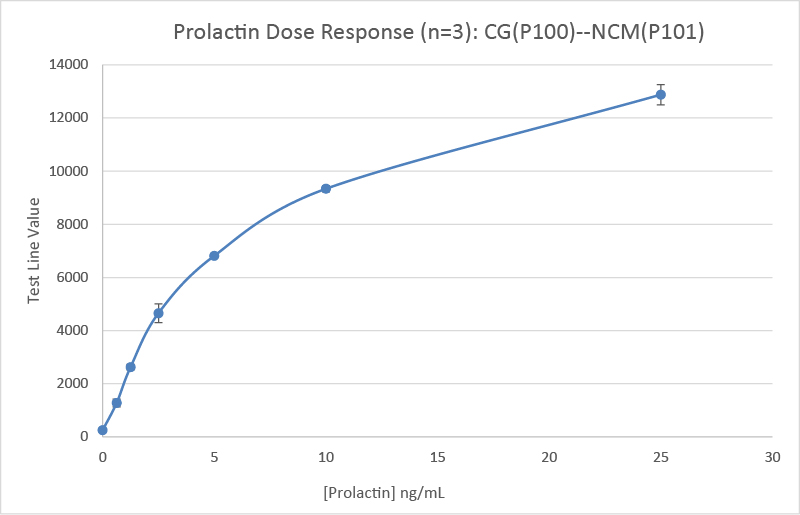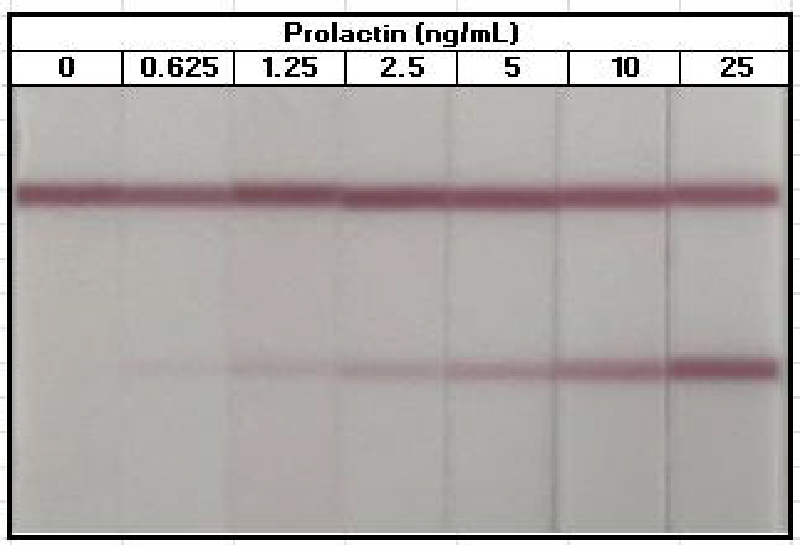Anti-Human Prolactin [Clone 172] — Purified
Anti-Human Prolactin [Clone 172] — Purified
Product No.: P100
- -
- -
Clone 172 Target Prolactin Formats AvailableView All Product Type Monoclonal Antibody Alternate Names Mammotropin, Luterotropic Hormone (LTH), Lutetropin Isotype IgG |
Data
 Prolactin LOD Graph
Prolactin LOD GraphA strong, curvilinear dose-response for prolactin was observed using a matched antibody pair: the Leinco P100 gold conjugate and the Leinco P101 nitrocellulose membrane antibody. The resulting data from the prolactin samples supports an exceptional analytical sensitivity, with a calculated Limit of Detection (LoD) of ≤0.625 ng/mL.
- -
- -
Antibody DetailsProduct DetailsReactive Species Human Host Species Mouse Immunogen Human Prolactin Product Concentration ≥ 5.0 mg/ml Purity ≥95% by SDS Page Formulation This purified antibody is supplied in 0.05 M phosphate buffered saline (PBS), pH 7.2 - 7.4, containing 0.1% sodium azide. as a preservative. State of Matter Liquid Storage and Handling This Purified Antibody is stable when stored at 2-8°C. Do not freeze. Cross Reactivity Paired with Leinco Prod. No. P101, Clone No. 174: Pro 100%, BhCG < 1%, ihCG < 1%, LH <1%, FSH < 1%.
Paired with Leinco Prod. No. P102, Clone No. 180: Pro 100%, BhCG < 1%, ihCG < 1%, LH <1%, FSH < 1%.
Country of Origin USA Shipping Next Day 2-8°C RRIDAB_2737554 Each investigator should determine their own optimal working dilution for specific applications. See directions on lot specific datasheets, as information may periodically change. DescriptionDescriptionSpecificity Mouse Anti-Human Prolactin (Clone 172) recognizes Human Prolactin. This monoclonal antibody was purified using multi-step affinity chromatography methods such as Protein A or G depending on the species and isotype. Background Prolactin (PRL) or Luteotropic hormone (LTH) is best known as the pituitary modulator of lactation and reproduction.1 Prolactin is a multifaceted hormone that is capable of modulating hundreds of physiological processes in adult vertebrates.2 PRL promotes proliferation, survival and migration of cancer cells acting via the prolactin receptor (PRLR).3 It also modulates maternal behavior and mediates hypothalamic pituitary adrenal axis inhibition during lactation via PRL receptors in the brain.4 Prolactin also has a number of other effects including contributing to surfactant synthesis of the fetal lungs at the end of the pregnancy and immune tolerance of the fetus by the maternal organism during pregnancy. It also decreases normal levels of sex hormones — estrogen in women and testosterone in men.5
Prolactin is a single chain polypeptide of 199 amino acids with a molecular weight of about 24,000 daltons. Its structure is similar to that of growth hormone and placental lactogen. The molecule is folded due to the activity of three disulfide bonds. Significant heterogeneity of the molecule has been described, thus bioassays and immunoassays can give different results due to differing glycosylation, phosphorylation, sulfation, as well as degradation. The non-glycosylated form of prolactin is the dominant form of prolactin that is secreted by the pituitary gland.
Increased serum concentrations of prolactin during pregnancy cause enlargement of the mammary glands of the breasts and increases the production of milk. However, the high levels of progesterone during pregnancy act directly on the breasts to stop ejection of milk. It is only when the levels of this hormone fall after childbirth that milk ejection is possible.
PubMed Research Area Hormones References & Citations1. Paus, R. et al. (2012) Arch Dermatol Res. 304(2):115-8. 2. Zhu, Y. et al. (2008) Comp Biochem Physiol C Toxicol Pharmacol. 148(4):370-80. 3. Panina, S. et al. (2009) J Endocrinol. 201(1):115-28. 4. Neuwmann, ID. et al. (2009) Endocrinology. 150(4):1841-9. 5. Molitch MD., ME. (2005) Mayo Clinic Proceedings 80(8):1050-1057 6. Gout, PW. et al. (1980) Cancer Research 40:2433-36. |
Related Products
- -
- -
Prod No. | Description |
|---|---|
P100 | |
P101 | |
P102 | |
H109 | |
H180 | |
H118 | |
P310 | |
P283 | |
P303 | |
P168 | |
P244 | |
P294 | |
B628 |
Formats Available
- -
- -
Prod No. | Description |
|---|---|
P100 | |
H108 |
 Products are for research use only. Not for use in diagnostic or therapeutic procedures.
Products are for research use only. Not for use in diagnostic or therapeutic procedures.



